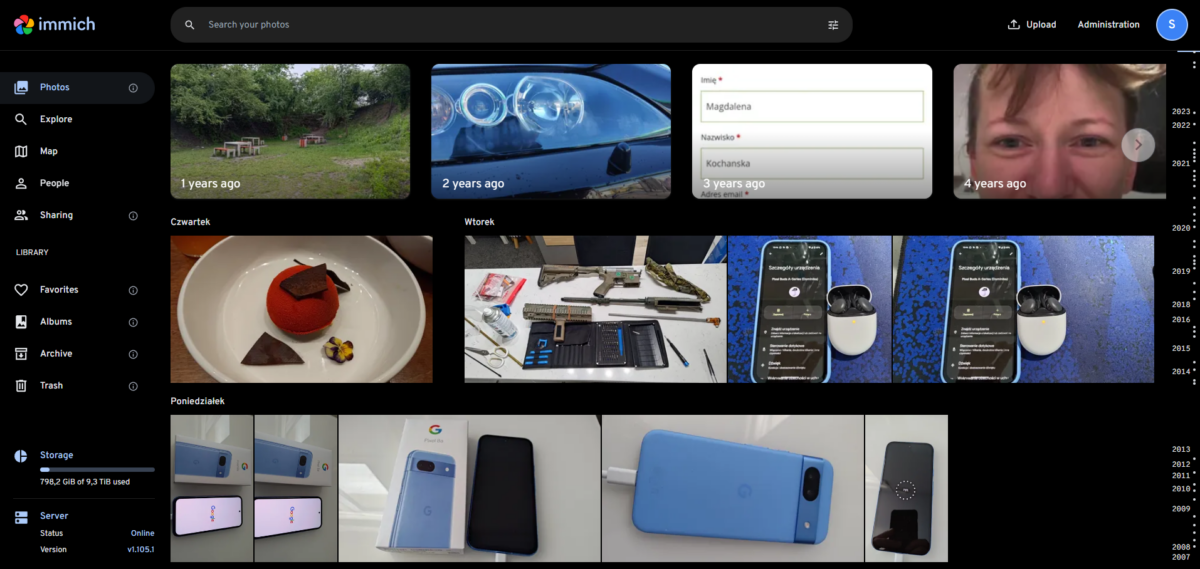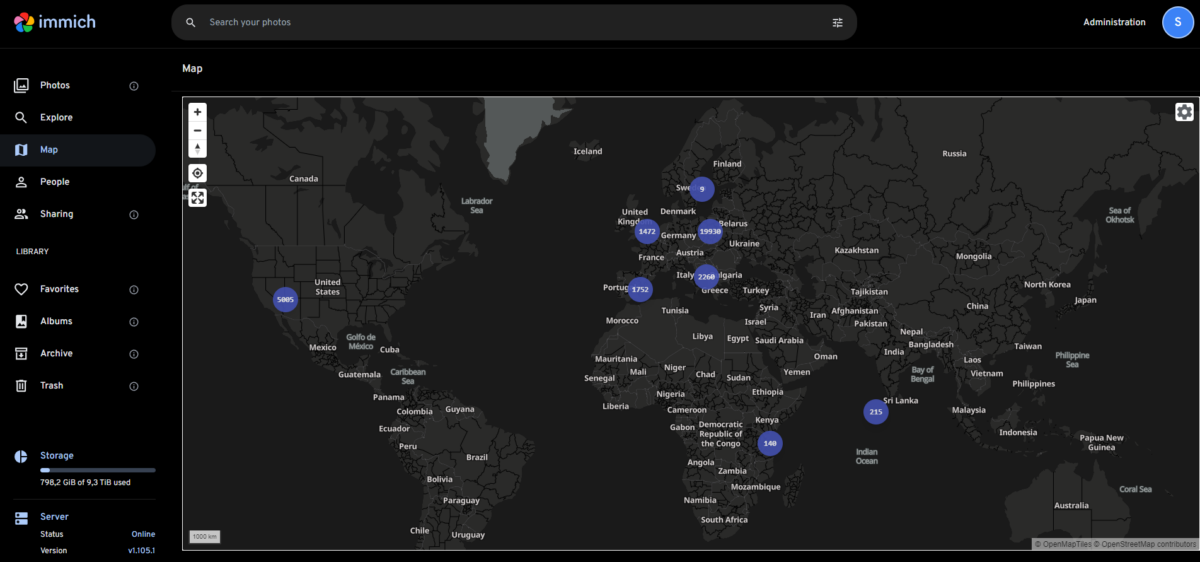Szukając zamiennika dla aktualnie używanych rozwiązań do hostowania, backupowania i zarządzania swoją biblioteką zdjęć natkąłem się na aplikację Immich.

Aplikację najłatwiej jest uruchomić korzystając z z instrukcji na ich stronie używając docker compose.
Zmodyfikowany przeze mnie docker-compose.yml wygląda następująco:
#
# WARNING: Make sure to use the docker-compose.yml of the current release:
#
# https://github.com/immich-app/immich/releases/latest/download/docker-compose.yml
#
# The compose file on main may not be compatible with the latest release.
#
name: immich
services:
immich-server:
container_name: immich_server
image: ghcr.io/immich-app/immich-server:${IMMICH_VERSION:-release}
command: ['start.sh', 'immich']
volumes:
- ${UPLOAD_LOCATION}:/usr/src/app/upload
- /etc/localtime:/etc/localtime:ro
- ${EXTERNAL_PATH}:/usr/src/app/external
env_file:
- stack.env
ports:
- 2283:3001
depends_on:
- redis
- database
restart: always
immich-microservices:
container_name: immich_microservices
image: ghcr.io/immich-app/immich-server:${IMMICH_VERSION:-release}
# extends: # uncomment this section for hardware acceleration - see https://immich.app/docs/features/hardware-transcoding
# file: hwaccel.transcoding.yml
# service: cpu # set to one of [nvenc, quicksync, rkmpp, vaapi, vaapi-wsl] for accelerated transcoding
command: ['start.sh', 'microservices']
volumes:
- ${UPLOAD_LOCATION}:/usr/src/app/upload
- /etc/localtime:/etc/localtime:ro
- ${EXTERNAL_PATH}:/usr/src/app/external
env_file:
- stack.env
depends_on:
- redis
- database
restart: always
immich-machine-learning:
container_name: immich_machine_learning
# For hardware acceleration, add one of -[armnn, cuda, openvino] to the image tag.
# Example tag: ${IMMICH_VERSION:-release}-cuda
image: ghcr.io/immich-app/immich-machine-learning:${IMMICH_VERSION:-release}
# extends: # uncomment this section for hardware acceleration - see https://immich.app/docs/features/ml-hardware-acceleration
# file: hwaccel.ml.yml
# service: cpu # set to one of [armnn, cuda, openvino, openvino-wsl] for accelerated inference - use the `-wsl` version for WSL2 where applicable
volumes:
- model-cache:/cache
env_file:
- stack.env
restart: always
redis:
container_name: immich_redis
image: registry.hub.docker.com/library/redis:6.2-alpine@sha256:84882e87b54734154586e5f8abd4dce69fe7311315e2fc6d67c29614c8de2672
restart: always
database:
container_name: immich_postgres
image: registry.hub.docker.com/tensorchord/pgvecto-rs:pg14-v0.2.0@sha256:90724186f0a3517cf6914295b5ab410db9ce23190a2d9d0b9dd6463e3fa298f0
environment:
POSTGRES_PASSWORD: ${DB_PASSWORD}
POSTGRES_USER: ${DB_USERNAME}
POSTGRES_DB: ${DB_DATABASE_NAME}
POSTGRES_INITDB_ARGS: '--data-checksums'
volumes:
- ${DB_DATA_LOCATION}:/var/lib/postgresql/data
restart: always
command: ["postgres", "-c" ,"shared_preload_libraries=vectors.so", "-c", 'search_path="$$user", public, vectors', "-c", "logging_collector=on", "-c", "max_wal_size=2GB", "-c", "shared_buffers=512MB", "-c", "wal_compression=on"]
volumes:
model-cache:
Dodatkowo poniżej jest przykładowy zestaw ENV których używam:
UPLOAD_LOCATION=/nfs/immich-app/library
DB_DATA_LOCATION=/nfs/immich-app/postgres
IMMICH_VERSION=release
DB_PASSWORD=SuperTajneHasloBazyDanych2137
DB_USERNAME=postgres
DB_DATABASE_NAME=immich
EXTERNAL_PATH=/zdjeciaDzięki temu posiadam własną stronę ze zdjęciami gdzie mogę tworzyć albumy, wyszukiwać zdjęcia i najważniejsze backupować zdjęcia z telefonu używając aplikacji 🙂


Linkografia:

